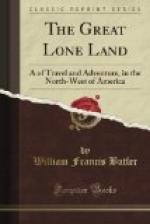In former times, when rum was used in the trade, the most frightful scenes were in the habit of occurring in the Indian room. The fire-water, although freely diluted with water soon reduced the assemblage to a state of wild hilarity, quickly followed by stupidity and sleep. The fire-water for the Crees was composed of three parts of water to one of spirit, that of the Blackfeet, seven of water to one of spirit, but so potent is the power which alcohol in any shape his well-diluted liquor, was wont to become helplessly intoxicated. The trade usually began with a present of-fire water all round—then the business went on apace. ’Horses, robes, tents, provisions, all would be proffered for one more drink at the beloved poison. Nothing could exceed the excitement inside the tent, except it was the excitement outside. There the anxious crowd could only learn by hearsay what was going on within. Now and then a brave, with an amount of self-abnegation worthy of a better cause, would issue from the tent with his cheeks distended and his mouth full of the fire-water, and going along the ranks of his friends he would squirt a little of the liquor into the open mouths of his less fortunate brethren.
But things did not always go so smoothly. Knives were wont to flash, shots to be fired—even-now the walls of the Indian rooms at Fort Pitt and Edmonton show many traces of bullet marks and knife hacking done in the wild fury of the intoxicated savage. Some ten years ago this most baneful distribution was stopped by the Hudson Bay Company in the Saskatchewan district, but the free traders still continued to employ alcohol as a means of acquiring the furs belonging to the Indians. I was the bearer of an Order in Council from the Lieutenant-Governor prohibiting, under heavy penalties, the sale, distribution, or possession of alcohol, and this law, if hereafter enforced, will do much to remove at least one leading source of Indian demoralization.




